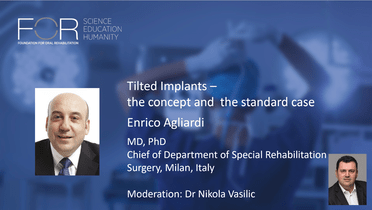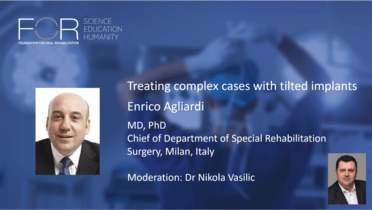-
0
Introduction
00:00 - 01:15
-
1
When to use zygomatic implants
01:16 - 04:26
-
2
Presentation patient case 1 with hybrid All-on-4
04:27 - 09:10
-
3
Presentation patient case 2 with hybrid All-on-4
09:11 - 16:57
-
4
Presentation patient case 3 with hybrid All-on-4(extra-maxillary)
16:58 - 23:18
-
5
Presentation patient case 4 with double zygoma implants
23:19 - 29:33
-
6
Presentation patient case 5 with double zygoma implants
29:34 - 33:10
-
7
Discussion
33:10 - 39:37
- 8 Community questions
Zygomatic implants focusing on treatment planning
Video highlights
- Indications for zygomatic implants
- Importance of diagnosis and treatment planning in severely atrophied jaws
- Case presentations with hybrid All-on-4
- Case presentations with double zygoma implants (quad-zygoma)
In the third part of the webinar series on Tilted Implants, Prof. Enrico Agliardi starts his presentation on the indications for the use of zygomatic implants.
Following the webinars on tilted implants and complex cases with tilted implants, Prof. Agliardi concludes the webinar series with the presentation on treatment options for patients with severely atrophied maxillae. These cases present themselves as very demanding to the surgeon as there is no residual bone available to place intraoral implants and also the placement of extraoral implants can be challenging. Prof. Agliardi presents patient cases where he treated the patients with a hybrid All-on-4 treatment and patient cases treated with double zygoma implants (quad-zygoma). He also stresses the fact that a proper analysis of the patient is the first and very important step in providing an optimal solution for the patient. He highlights also the aesthetic impact that these patients suffer from and which should be considered in the treatment planning, next to the restoration of function, as this significantly improves the quality of life for these patients.
After his presentation, Prof. Agliardi discusses the challenges of theses cases with the moderator of the webinar series, Dr. Nikola Vasilic.
References:
[1] Maló P, de Araújo Nobre M, Lopes A, Ferro A, Moss S. Extramaxillary surgical technique: clinical outcome of 352 patients rehabilitated with 747 zygomatic implants with a follow-up between 6 months and 7 years. Clin Implant Dent Relat Res. 2015 Jan;17 Suppl 1:e153-62. doi: 10.1111/cid.12147. Epub 2013 Sep 4. PMID: 24004279.
[2] Maló P, Nobre Md, Lopes A, Francischone C, Rigolizzo M. Three-year outcome of a retrospective cohort study on the rehabilitation of completely edentulous atrophic maxillae with immediately loaded extra-maxillary zygomatic implants. Eur J Oral Implantol. 2012 Spring;5(1):37-46. PMID: 22518378.
[3] Agliardi EL, Romeo D, Panigatti S, de Araújo Nobre M, Maló P. Immediate full-arch rehabilitation of the severely atrophic maxilla supported by zygomatic implants: a prospective clinical study with minimum follow-up of 6 years. Int J Oral Maxillofac Surg. 2017 Dec;46(12):1592-1599. doi: 10.1016/j.ijom.2017.05.023. Epub 2017 Jun 24. PMID: 28655434.
[4] Agliardi EL, Panigatti S, Romeo D, Sacchi L, Gherlone E. Clinical outcomes and biological and mechanical complications of immediate fixed prostheses supported by zygomatic implants: A retrospective analysis from a prospective clinical study with up to 11 years of follow-up. Clin Implant Dent Relat Res. 2021 Aug;23(4):612-624. doi: 10.1111/cid.13017. Epub 2021 Jun 22. PMID: 34159707.




Do you use a specific retractor to expose the zygomatic arch during zygomatic fixture placement? Ron D Thoman OMFS. USA
In reply to Do you use a specific retractor to expose the zygomatic arch during zygomatic fixture placement? Ron D Thoman OMFS. USA by Anonymous
Dear Ron, I use the retractor you can see in these images, it is very helpful in exposing the zygomatic arch and see where to place the implant tip.